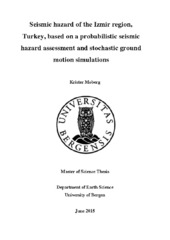| dc.description.abstract | The purpose of this thesis is to conduct a seismic hazard analysis of the region surrounding Izmir. The chosen area is located in a very active seismic region with a high seismicity due to large amount of earthquakes. In the past, several destructive and deadly earthquakes have affected this region. These destructive earthquakes can potentially be very dangerous and affect millions of people, especially in densely populated coastal areas close to Izmir. Due to previous severe earthquakes, the public awareness of potential new destructive earthquakes in the region is high. In this thesis, an analysis of the seismic hazard in a broad region surrounding Izmir is performed. Two ground motion methods are conducted in order to measure the maximum ground motion in terms of acceleration of gravity. One of the methods is a probabilistic seismic hazard assessment, computing ground motion values by using different return periods for a fixed probability of exceedance. The second method includes stochastic ground motion simulations, giving maximum possible ground motion values from several large faults by using a reference earthquake, such as the Izmir fault, the Manisa fault, the Karaburun fault, the Seferihisar fault, the Tuzla fault or the Samos fault. Three areas are identified with a significant hazard. These areas include the Izmir metropolitan, the area between the cities of Manisa, Akhisar and Salihli, and the northern part of the Karaburun Peninsula. The highest identified PGA values, by using the PSHA, are found in the area between the cities of Manisa, Akhisar and Salihli. This area have a PGA of up to 0.33g, by using a return period of 475 years. In the Izmir metropolitan, the highest PGA values using the PSHA with a return period of 475 years is 0.27g. By using the stochastic simulation, a maximum PGA value of 0.3g was found at the Izmir fault, using a reference earthquake of MW = 6.8. A maximum PGA value of 0.5g was found using a reference earthquake of MW = 6.9 on both the Karaburun and the Tuzla fault. A maximum PGA value of 0.6g was found using a reference earthquake of MW = 6.6 on the Seferihisar fault. Other high PGA values between 0.2g and 0.3g were found by using stochastic simulations on the Manisa and the Samos fault. | en_US |
